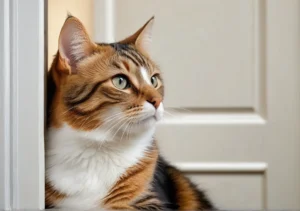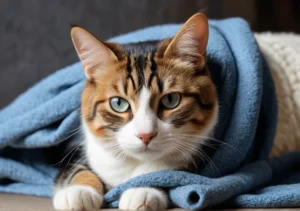Cats are fascinating creatures with a multitude of quirky behaviors that can leave us wondering ‘why?’ One such behavior that often perplexes cat owners is when their feline friends pace in circles. This repetitive and seemingly purposeless action may have you scratching your head and wondering what could possibly be going on in your cat’s mind.
There are several reasons why cats may engage in this peculiar behavior. One possible explanation is that pacing in circles is a way for cats to mark their territory. By walking in a circular pattern, cats may be leaving behind their scent through the glands in their paws, essentially claiming that area as their own. This territorial behavior is instinctual for cats, who are naturally inclined to establish and maintain boundaries in their environment. But there may be more to it than just marking territory. Let’s explore the reasons behind why cats pace in circles.
Seeking Attention
Does your cat seem to be pacing in circles around you constantly? Well, they might just be looking to grab some extra love and attention! As social creatures, cats crave interaction and affection from their human companions. When they feel neglected or bored, they may resort to pacing in circles as a way to say, “Hey, pay attention to me!”
If you notice your feline friend displaying this behavior, try engaging them in playtime with interactive toys or simply spending quality time together. Offering affection and attention can go a long way in curbing their pacing habits and strengthening your bond. Remember, a little love goes a long way in keeping your cat happy and content!
Hunting Instincts
Have you ever observed your cat pacing in circles with a look of intense focus in their eyes? This behavior could be linked to their innate hunting instincts. Cats, despite their domestication, still retain strong predatory instincts. When they pace in circles, they are mimicking the movements of stalking and capturing prey.
To channel this instinctual behavior in a positive way, consider providing your cat with interactive toys that simulate hunting scenarios. Toys that involve chasing, pouncing, and capturing can help satisfy your cat’s need to engage in hunting-like activities. By tapping into their natural instincts in a safe and controlled environment, you can help keep your cat entertained and mentally stimulated.
Tip: Provide your cat with puzzle feeders. Another way to satisfy your cat’s hunting instincts is by using puzzle feeders. These devices require your cat to figure out how to access their food, simulating the challenge of hunting and foraging for their meals. Puzzle feeders can keep your cat engaged and mentally sharp while reducing pacing behaviors.
Stress or Anxiety
If you notice your feline friend pacing in circles, it could be a sign of stress or anxiety. Just like humans have different ways of coping with these emotions, cats may resort to pacing. Try to create a calming environment for your cat by providing cozy hiding spots, interactive toys, or even pheromone diffusers to help them relax.
Medical Conditions
Pacing in circles could also be a red flag for underlying medical conditions. Keep an eye out for other symptoms like changes in appetite, weight loss, or increased thirst and urination. Hyperthyroidism or cognitive dysfunction could be culprits, so a trip to the vet might be in order to rule out any serious health issues.
Additional Unique Insight:
- Ear Infections: Sometimes, cats may exhibit pacing in circles due to discomfort caused by ear infections. If your cat is tilting their head, scratching at their ears, or showing signs of pain, it’s essential to seek veterinary attention promptly.
Remember, your feline companion’s well-being is a top priority, so being attentive to their behavior and addressing any concerns promptly is crucial for their health and happiness.
Environmental Enrichment
Is your cat pacing in circles? This behavior could indicate boredom or lack of mental stimulation. To prevent this, focus on enriching your cat’s environment. Create vertical spaces for climbing, provide hiding spots like boxes or tunnels, and offer interactive toys to keep them engaged. Additionally, consider rotating their toys regularly to keep things interesting. Cats thrive in stimulating environments, so invest in scratching posts, cat trees, and window perches to fulfill their natural instincts. By providing a variety of enriching activities, you can keep your cat happy, active, and entertained.
Providing Mental Stimulation
Wondering why your cat is pacing in circles? It might be craving mental stimulation. Cats are intelligent creatures that need mental challenges to stay sharp. Invest in interactive toys such as puzzle feeders or treat dispensers to keep them engaged. Hide treats around the house or create DIY toys using household items. Engage your cat in play sessions with wand toys or laser pointers. Consider setting up a bird feeder outside a window for added entertainment. By offering a mix of mental stimulation activities, you can help curb pacing behaviors and keep your cat mentally stimulated and content.
Extra tip: Consider introducing a rotating schedule of activities to keep your cat mentally engaged and prevent boredom. Change up their routine regularly to maintain their interest and prevent pacing behaviors.
Training and Behavior Modification
If your cat is constantly pacing in circles, it may be time to consider some positive reinforcement training techniques. By using rewards like treats, toys, or extra attention when your cat displays desired behaviors like sitting calmly or playing with a toy instead of pacing, you can help reinforce these positive actions.
Consistency is key when training your cat, so be sure to reward them every time they exhibit the behavior you want to encourage. This will help them associate the positive reinforcement with the specific action, making it more likely they will repeat it in the future.
Another helpful technique is to redirect your cat’s energy towards more appropriate activities. Providing them with interactive toys, puzzle feeders, or designated playtime can help keep them mentally and physically stimulated, reducing the need for pacing behavior.
Remember, patience is essential when training your cat. It may take time for them to learn new behaviors, so be sure to be consistent and gentle with your corrections. With time and dedication, you can help modify your cat’s pacing behavior and encourage more positive interactions.
Additional Tip:
– Consider consulting with a professional animal behaviorist for personalized advice and guidance on how to address your cat’s pacing behavior effectively.
By taking a proactive approach to understanding and modifying your cat’s pacing behavior, you can strengthen the bond between you and your feline friend, leading to a happier and more fulfilling relationship.
Understanding Your Cat’s Needs
When trying to decipher why your cat is pacing in circles, it’s essential to consider their basic needs. Cats are known for their independent nature, but they still require mental and physical stimulation to thrive.
Ensure that your cat has plenty of opportunities for play, exploration, and social interaction to help fulfill their natural instincts. Providing engaging toys, scratching posts, vertical space to climb, and interactive play sessions can help keep your cat mentally engaged and physically active.
Additionally, make sure your cat has a comfortable and safe environment to relax and rest when they need to recharge. A cozy bed, access to sunny spots for lounging, and a quiet space away from loud noises or distractions can help your cat feel secure and content.
By meeting your cat’s basic needs for mental and physical stimulation, you can help reduce their urge to pace in circles and promote overall well-being.
Remember, understanding your cat’s unique personality and preferences is key to ensuring they lead a happy and fulfilled life.
Provide your feline friend with the love, care, and attention they deserve, and you’ll be rewarded with a strong and trusting bond that will last a lifetime.
Alex, a passionate animal lover, has experience in training and understanding animal behavior. As a proud pet parent to two dogs and three cats, he founded AnimalReport.net to share insights from animal experts and expand his knowledge of the animal kingdom.




